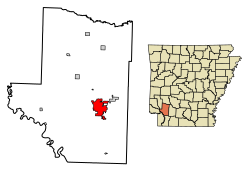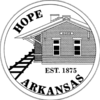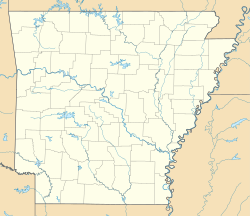Hope is a city in Hempstead County in southwestern Arkansas, United States. Hope is the county seat of Hempstead County[3] and the principal city of the Hope Micropolitan Statistical Area, which includes all of Hempstead and Nevada counties. As of the 2010 census the population was 10,095,[4] and in 2019 the population was estimated at 9,599.[5]
Hope, Arkansas | |
|---|---|
City | |
 Downtown Hope | |
| Motto(s): "A Slice of the Good Life" "I still believe in a place called Hope" | |
 Location of Hope in Hempstead County, Arkansas | |
| Coordinates: 33°40′35″N 93°35′24″W / 33.67639°N 93.59000°W | |
| Country | |
| State | |
| County | Hempstead |
| Founded | 1875 |
| Government | |
| • Type | Council-Manager |
| Area | |
• City | 10.76 sq mi (27.87 km2) |
| • Land | 10.68 sq mi (27.67 km2) |
| • Water | 0.08 sq mi (0.20 km2) |
| Elevation | 351 ft (107 m) |
| Population (2020) | |
• City | 8,952 |
| • Density | 837.97/sq mi (323.55/km2) |
| • Metro | 30,591 |
| Time zone | UTC-6 (CST) |
| • Summer (DST) | UTC-5 (CDT) |
| ZIP codes | 71801-71802 |
| Area code | 870 |
| FIPS code | 05-33190 |
| GNIS feature ID | 2404726[2] |
| Website | www |
Hope is the birthplace of three Arkansas governors: Bill Clinton (who was also President of the United States from 1993 to 2001), Mike Huckabee (who ran for the Republican presidential nomination in 2008 and 2016), and Sarah Huckabee Sanders (the incumbent governor and daughter of Mike Huckabee).
History
editHope began in 1873, when a railroad was built through the area. The town was named for Hope Loughborough, the daughter of a railroad executive.[6][7] In the 1902–1903 timeframe, the St. Louis, San Francisco and New Orleans Railroad was built into town; that line is now operated by the Kiamichi Railroad.[8][9][10]
Geography
editAccording to the United States Census Bureau, the city has a total area of 10.2 square miles (26.3 km2), of which 10.1 square miles (26.1 km2) are land and 0.1 square miles (0.2 km2), or 0.74%, are water.[4]
Climate
editThe climate is characterized by hot, humid summers and generally mild to cool winters. According to the Köppen Climate Classification system, Hope has a humid subtropical climate, abbreviated Cfa on climate maps.[11]
| Climate data for Hope, Arkansas (1991–2020 normals, extremes 1892–present) | |||||||||||||
|---|---|---|---|---|---|---|---|---|---|---|---|---|---|
| Month | Jan | Feb | Mar | Apr | May | Jun | Jul | Aug | Sep | Oct | Nov | Dec | Year |
| Record high °F (°C) | 88 (31) |
87 (31) |
95 (35) |
97 (36) |
98 (37) |
110 (43) |
115 (46) |
115 (46) |
108 (42) |
101 (38) |
90 (32) |
83 (28) |
115 (46) |
| Mean daily maximum °F (°C) | 53.3 (11.8) |
57.9 (14.4) |
65.8 (18.8) |
73.9 (23.3) |
80.8 (27.1) |
88.1 (31.2) |
92.1 (33.4) |
92.5 (33.6) |
86.4 (30.2) |
76.0 (24.4) |
64.2 (17.9) |
55.6 (13.1) |
73.9 (23.3) |
| Daily mean °F (°C) | 42.4 (5.8) |
46.2 (7.9) |
53.8 (12.1) |
61.6 (16.4) |
70.2 (21.2) |
77.7 (25.4) |
81.5 (27.5) |
81.0 (27.2) |
74.6 (23.7) |
63.2 (17.3) |
52.2 (11.2) |
44.6 (7.0) |
62.4 (16.9) |
| Mean daily minimum °F (°C) | 31.5 (−0.3) |
34.5 (1.4) |
41.7 (5.4) |
49.3 (9.6) |
59.5 (15.3) |
67.4 (19.7) |
70.9 (21.6) |
69.5 (20.8) |
62.7 (17.1) |
50.4 (10.2) |
40.3 (4.6) |
33.6 (0.9) |
50.9 (10.5) |
| Record low °F (°C) | −8 (−22) |
−7 (−22) |
9 (−13) |
26 (−3) |
35 (2) |
45 (7) |
53 (12) |
50 (10) |
34 (1) |
25 (−4) |
13 (−11) |
2 (−17) |
−8 (−22) |
| Average precipitation inches (mm) | 4.28 (109) |
4.52 (115) |
5.10 (130) |
5.63 (143) |
5.84 (148) |
4.26 (108) |
3.78 (96) |
3.49 (89) |
3.99 (101) |
4.94 (125) |
4.42 (112) |
5.44 (138) |
55.69 (1,415) |
| Average snowfall inches (cm) | 1.3 (3.3) |
0.5 (1.3) |
0.1 (0.25) |
0.0 (0.0) |
0.0 (0.0) |
0.0 (0.0) |
0.0 (0.0) |
0.0 (0.0) |
0.0 (0.0) |
0.0 (0.0) |
0.0 (0.0) |
0.2 (0.51) |
2.1 (5.3) |
| Average precipitation days (≥ 0.01 in) | 10.6 | 9.8 | 10.3 | 9.2 | 9.8 | 8.0 | 7.2 | 6.5 | 6.4 | 7.8 | 9.5 | 9.6 | 104.7 |
| Average snowy days (≥ 0.1 in) | 0.3 | 0.4 | 0.1 | 0.0 | 0.0 | 0.0 | 0.0 | 0.0 | 0.0 | 0.0 | 0.0 | 0.2 | 1.0 |
| Source: NOAA[12][13] | |||||||||||||
Demographics
edit| Census | Pop. | Note | %± |
|---|---|---|---|
| 1880 | 1,233 | — | |
| 1890 | 1,937 | 57.1% | |
| 1900 | 1,644 | −15.1% | |
| 1910 | 3,639 | 121.4% | |
| 1920 | 4,790 | 31.6% | |
| 1930 | 6,008 | 25.4% | |
| 1940 | 7,475 | 24.4% | |
| 1950 | 8,605 | 15.1% | |
| 1960 | 8,399 | −2.4% | |
| 1970 | 8,830 | 5.1% | |
| 1980 | 10,290 | 16.5% | |
| 1990 | 9,643 | −6.3% | |
| 2000 | 10,616 | 10.1% | |
| 2010 | 10,095 | −4.9% | |
| 2020 | 8,952 | −11.3% | |
| U.S. Decennial Census[14] | |||
2020 census
edit| Race | Num. | Perc. |
|---|---|---|
| White (non-Hispanic) | 2,530 | 28.26% |
| Black or African American (non-Hispanic) | 3,950 | 44.12% |
| Native American | 25 | 0.28% |
| Asian | 25 | 0.28% |
| Pacific Islander | 4 | 0.04% |
| Other/Mixed | 301 | 3.36% |
| Hispanic or Latino | 2,117 | 23.65% |
As of the 2020 United States census, there were 8,952 people, 3,375 households, and 2,447 families residing in the city.
2010 census
editAs of the 2010 United States Census, there were 10,095 people living in the city. The racial makeup of the city was 43.2% Black, 34.0% White, 0.2% Native American, 0.2% Asian, 0.1% Pacific Islander, 0.1% from some other race and 1.4% from two or more races. 20.8% were Hispanic or Latino of any race.
2000 census
editAs of the census[16] of 2000, there were 10,616 people, 3,961 households, and 2,638 families living in the city. The population density was 1,061.9 inhabitants per square mile (410.0/km2). There were 4,301 housing units at an average density of 430.2 per square mile (166.1/km2). The racial makeup of the city was 47.71% White, 43.17% Black or African American, 0.38% Native American, 0.30% Asian, 0.03% Pacific Islander, 6.63% from other races, and 1.78% from two or more races. 13.48% of the population were Hispanic or Latino of any race.
There were 3,961 households, out of which 34.3% had children under the age of 18 living with them, 40.8% were married couples living together, 21.0% had a female householder with no husband present, and 33.4% were non-families. Of 3,961 households, 192 are unmarried partner households: 175 heterosexual. 29.3% of all households were made up of individuals, and 13.8% had someone living alone who was 65 years of age or older. The average household size was 2.61 and the average family size was 3.20.
In the city, the population was spread out, with 28.9% under the age of 18, 10.8% from 18 to 24, 27.3% from 25 to 44, 18.4% from 45 to 64, and 14.6% who were 65 years of age or older. The median age was 32 years. For every 100 females, there were 87.3 males. For every 100 females age 18 and over, there were 81.7 males.
The median income for a household in the city was $25,385, and the median income for a family was $28,445. Males had a median income of $23,525 versus $17,394 for females. The per capita income for the city was $12,783. About 22.3% of families and 27.2% of the population were below the poverty line, including 41.1% of those under age 18 and 17.3% of those age 65 or over.
Economy
editHope is also known for growing watermelons and continues to produce records for the largest specimens in the world. The last record was set by Lloyd Bright in 2005 with a 268.8-pound watermelon. The Watermelon Festival is celebrated annually from Thursday-Saturday during the second week of August. The watermelon is used in the municipal logo and the Hope slogan: A Slice of the Good Life.
Education
editPublic education at the elementary and secondary school level within the Hope city limits is provided by the Hope School District.[17] Hope School District includes William Jefferson Clinton Primary School for kindergarten through fourth Grade, Beryl Henry Elementary School for fifth and sixth grade, Henry C. Yerger Middle School for seventh and eighth grade, and Hope High School for ninth through twelfth grades. Hope Academy of Public Service (HAPS) fifth through eighth grades, HAPS Freshman Academy ninth grade, HAPS Collegiate Academy tenth through twelfth grades.
Hope also has a private school, Garrett Memorial Christian School associated with Garrett Memorial Baptist Church.
Post-secondary educational opportunity is provided by the University of Arkansas at Hope.[18]
The Spring Hill School District, while having a Hope postal address, is based outside of the city limits.[17][19]
Media
editHope has three forms of local media. SWARK.Today and HopePrescott serve as the city's two Social Media News websites. HopePrescott also produces the city's newspaper. There are also at least three local radio stations in and around Hope. The city is served by local television stations from the Little Rock, Arkansas, Shreveport, Louisiana and Texarkana, Texas Ark-La-Tex markets. There are currently no local TV stations for Hope.
Infrastructure
editAirport
editHope Municipal Airport is located on property that was once part of the Southwestern Proving Ground, one of six major military facilities in Arkansas during World War II.
At the time of its construction, the airport held claim of having the third longest runway in the United States. From 1942 to 1945 the airport and surrounding 50,078-acre Southwestern Proving Ground were used by the U.S. Army to test small arms ammunition, 20 to 155 mm projectiles, mortars, rockets, grenades, and up to 500-pound bombs. The City of Hope received the airport facility in 1947.
Paul Klipsch, a United States Army Veteran who served at the site, was among those who started businesses in the re-purposed buildings. He established Klipsch speaker company there and was known to joke that his desk was not in the same spot as the one he had during his service. "It was" he said, "on the other side of the room."
In the aftermath of Hurricane Katrina in 2005, FEMA used land near the airport as a staging area for manufactured homes intended as temporary housing for the hurricane victims; however, as of 2009, infrastructure and property damage remained so severe in the hurricane's path that many homes remained at the airport, eliciting criticism of the federal agency.
Rail service
editIn October 2009, Amtrak added Hope to its timetable brochure for its Texas Eagle service. On March 24, 2013, it was announced that service would begin on April 4.[20] The Texas Eagle travels daily in each direction between Chicago and San Antonio.[21][22]
Notable people
edit- Hope is the hometown of former U.S. president Bill Clinton, whose childhood home is located in the town. At the 1992 Democratic National Convention in New York City, then-governor Clinton ended his acceptance speech by saying, "I still believe in a place called Hope." The city adopted this statement as its unofficial motto. The city converted its railroad depot to a museum about Clinton's life.
- Hope is also the hometown of the former governor and 2008 and 2016 presidential candidate Mike Huckabee alongside his daughter current governor Sarah Huckabee Sanders[23]
- Navy SEAL and CIA Contractor Jeremy Wise
- 20th-century congressman Tilman Bacon Parks[24]
- Former U.S. Congressman Joseph Barton Elam of Louisiana's 4th congressional district
- former White House chief of staff Mack McLarty
- Attorney Vince Foster
- California Secretary of State Shirley Weber
- Former Arkansas secretary of state Kelly Bryant
- Former Louisville, Kentucky mayor David L. Armstrong
- Talk radio host Gary Dee
- PGA golfer Ken Duke
- Actress/vocalist Ketty Lester
- Actress Melinda Dillon
- Paul Klipsch founded Klipsch and Associates in Hope in 1946. Klipsch invented the world-famous Klipschorn speaker, a folded horn loaded speaker that revolutionized the industry. The Klipschorn and a number of other speaker lines are still manufactured in Hope by Klipsch Audio Technologies
- Former U.S. representative Mike Ross of Arkansas's 4th congressional district is a former resident of Hope.
References
edit- ^ "2020 U.S. Gazetteer Files". United States Census Bureau. Retrieved October 29, 2021.
- ^ a b U.S. Geological Survey Geographic Names Information System: Hope, Arkansas
- ^ "Find a County". National Association of Counties. Archived from the original on May 31, 2011. Retrieved June 7, 2011.
- ^ a b "Geographic Identifiers: 2010 Demographic Profile Data (G001): Hope city, Arkansas". American Factfinder. U.S. Census Bureau. Retrieved April 19, 2017.[dead link]
- ^ "Population and Housing Unit Estimates". Retrieved May 21, 2020.
- ^ "Hope (Hempstead County)". Encyclopedia of Arkansas. The Central Arkansas Library System. Retrieved June 25, 2014.
- ^ Gannett, Henry (1905). The Origin of Certain Place Names in the United States. Govt. Print. Off. pp. 160.
- ^ "Hope, AR" (PDF). All Aboard, January–February 1994, p.17-18, The Frisco Rail Museum, (accessed on CondrenRails.com). Retrieved October 11, 2022.
- ^ "Kiamichi Railroad Company KRR #424". Union Pacific. Retrieved October 11, 2022.[dead link]
- ^ "Railroad Map of Arkansas" (PDF). Arkansas Department of Transportation. Retrieved October 11, 2022.
- ^ "Hope, Arkansas Köppen Climate Classification (Weatherbase)". Weatherbase.
- ^ "NOWData - NOAA Online Weather Data". National Oceanic and Atmospheric Administration. Retrieved November 2, 2023.
- ^ "Summary of Monthly Normals 1991-2020". National Oceanic and Atmospheric Administration. Retrieved November 2, 2023.
- ^ "Census of Population and Housing". Census.gov. Retrieved June 4, 2015.
- ^ "Explore Census Data". data.census.gov. Retrieved December 10, 2021.
- ^ "U.S. Census website". United States Census Bureau. Retrieved January 31, 2008.
- ^ a b "SCHOOL DISTRICT REFERENCE MAP (2010 CENSUS): Hempstead County, AR" (PDF). U.S. Census Bureau. Retrieved February 27, 2021.
- ^ "Univ of Arkansas CC Hope". usnews.com. Retrieved April 27, 2019.
- ^ "Home". Spring Hill School District. Retrieved February 27, 2021.
633 Highway 355 W Hope , Arkansas 71801
- ^ "Amtrak Texas Eagle adds stop in Hope, ARK" (PDF). Archived from the original (PDF) on May 20, 2013.
- ^ Harris-Smith, Stephanie (September 18, 2009). "Amtrak still rolling Hope's way". Hope Star. Hope, Arkansas: GateHouse Media, Inc. Archived from the original on July 12, 2011. Retrieved December 8, 2009.
- ^ "Texas Eagle And Heartland Flyer" (PDF). National Railroad Passenger Corp. October 26, 2009. Archived from the original (PDF) on October 29, 2009. Retrieved December 8, 2009.
- ^ Mike Huckabee, From Hope to Higher Ground, New York: Center Street Publishers, 2007, pp. 3–4
- ^ William H. Pruden III. "Biography of Tilman Bacon Parks". Encyclopedia of Arkansas.


